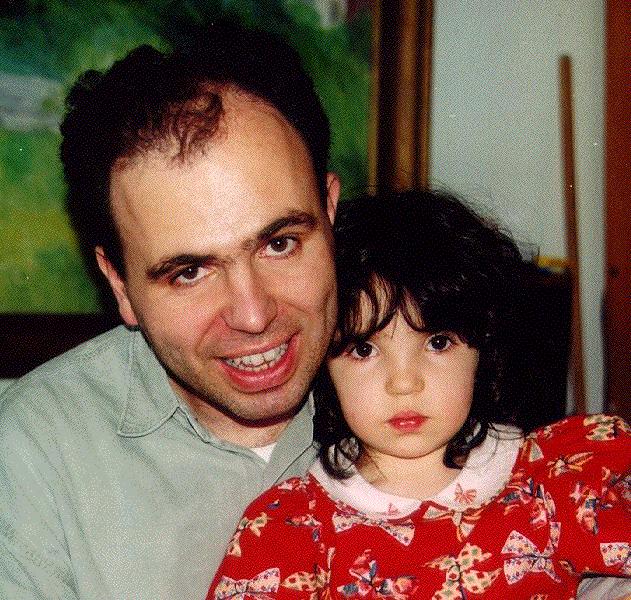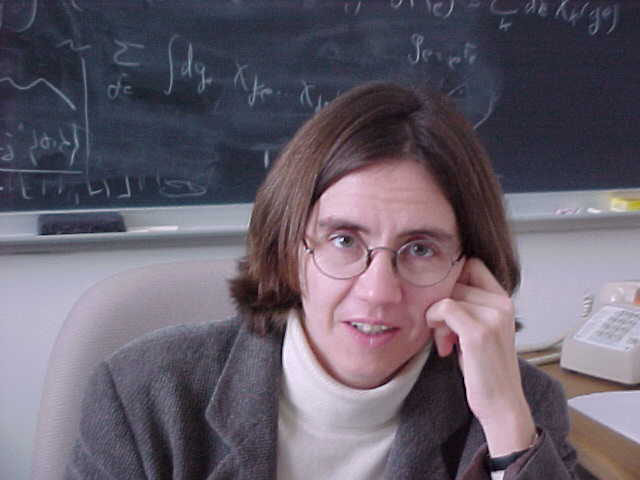by Jan
Ambjørn, K. N. Anagnostopoulos
and
R. Loll



by Jan
Ambjørn, K. N. Anagnostopoulos
and
R. Loll



This home page contains visualizations of some our simulations of a model of 2d Lorentzian Quantum Gravity. Details about the model can be found in [ 1 , 2, 3 ].
This is easily possible because of the causal structure of the surfaces. Each time slice is embedded isometrically in 3d space and then the vertices of adjoint slices are connected. An arbitrary copy of Ising spins is used for the colouring of the surface where a different colour is used for each spin state. The surface is embedded as a cylinder where it is understood that its top and bottom have to be identified. By looking at those pictures one can get information about the length distribution of spatial slices, the connectivity distribution and the size and distribution of spin clusters of each spin copy.
The animations shown here were created by viewing sequential configurations using the 3D geometry viewing program Geomview [ 4 ] of the Geometry Center at the University of Minnesota . Our program simply created files in the OOGL format. Then individual frames were captured and assembled in animated gif files.
You may view our simulations by simply clicking at the pictures below. If your browser is smart enough (let us not elaborate on that) you will be able to see the animated sequence of configurations. Nothing moves in the beginning so don't panick. The first 5 frames is a banner giving you the parameters of the simulations. In case you get impatient with the speed of the network you may download a tar gzipped archive containing all the necessary files. After you save and unpack, open this file locally with your browser. Or use software like animate created by Image Magick .
First we show our simulations for pure gravity. A N=9408, t=168 (tau=N/t^2=3) system is shown. Fluctuations are large but the system is similar to a tau=1 system:
Then the simulations for the c=1/2 system (1 Ising model). The system
shown here has N= 19200, t= 240, tau= 3. Again the system is the same as
the tau= 1 system. The spin configurations are beta=0 configurations.
Finally the c=4 system has qualitatively different behaviour. A "blob" which scales non-trivially with system size appears. From its scaling we conclude that the cosmological Hausdorff dimension is d_H=3! For the systems mentioned above it has been found to be 2. This anomalous scaling manifests itself by looking at the dimensions of a typical time direction scale dim[T] and the typical length of a universe in the "blob" dim[L] . We find that dim[L]=2 dim[T] whereas one usually expects that dim[L]=dim[T]. The latter relations are valid for the c=0,1/2 systems. The latter dimensional relations are confirmed by direct measurements of the two point function. They are identical to the ones found in Liouville gravity for the higher moments <L^n> n>1, sensitive only to the scaling of large loops and not to loops of the cutoff scale! At this point another interesting property of the system appears. Although the cosmological Hausdorff dimension is 3 the geometry at short scales is 2 dimensional. The only other system known with different d_h and d_H are the multicritical branched polymers which have d_h=2 at small scales whereas their "cosmological" dimension d_H varies from 2 to 1 (here d_H<= d_h).
Here you can see the tau=3 system for approximately equal sizes. Notice
that for the tau= 1 system the "blob" barely makes its appearance. This
shows that tau>1 simulations are necessary in order to minimize finite
size effects which "hide" the "blob". First we show systems of approximately
equal volume with tau=1 (N=8100,t=90), tau= 2 (N=8192, t= 128), tau= 3
(N= 9408, t= 168) and tau= 4 (N=8464, t= 184):
Finally we show you our largest systems for tau= 1 (N=16384, t= 128 and N= 32400, t= 180):
as well as for tau= 3 (N= 19200, t= 240 and N= 36963, t= 333):
Update 12/4/2011: Higher resolution simulations
Click on the links below for higher resolution simulations. The original format of the animations is OGG Vorbis which is native on Linux boxes. If you are
unfortunate enought to live in a different environement you may need codecs. A good, free piece of software is
VLC which you may download for a variety of operating systems. Otherwise watch
in the (recoded) mpeg4 avi using the links in the parentheses:
References:
[1] Jan
Ambjørn and R. Loll: Non-perturbative
Lorentzian quantum gravity, causality and topology change, Nucl.
Phys. B536 (1998) 407-434, [hep-th/9805108]
.
[2] Jan
Ambjørn, K. N. Anagnostopoulos and R. Loll: A
new perspective on matter coupling in 2d quantum gravity, Phys. Rev. D
(to
appear), [hep-th/9904012]
.
[3] Jan
Ambjørn , K. N. Anagnostopoulos and R. Loll: Crossing
the c=1 Barrier in 2d Lorentzian Quantum Gravity.
[4] M.
Phillips, S. Levy and T. Munzner: Geomview:
An interactive Geometry Viewer, Notices of the American Mathematical
Society 40 (1993) 985-988.